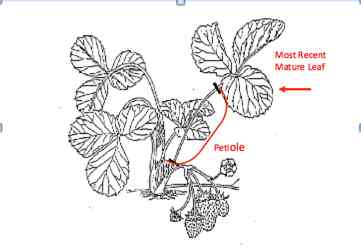Optimize Strawberry Fertility With Plant Tissue Testing (7:30pm, Mon., 3/16/15)
go.ncsu.edu/readext?345870
en Español / em Português
El inglés es el idioma de control de esta página. En la medida en que haya algún conflicto entre la traducción al inglés y la traducción, el inglés prevalece.
Al hacer clic en el enlace de traducción se activa un servicio de traducción gratuito para convertir la página al español. Al igual que con cualquier traducción por Internet, la conversión no es sensible al contexto y puede que no traduzca el texto en su significado original. NC State Extension no garantiza la exactitud del texto traducido. Por favor, tenga en cuenta que algunas aplicaciones y/o servicios pueden no funcionar como se espera cuando se traducen.
Português
Inglês é o idioma de controle desta página. Na medida que haja algum conflito entre o texto original em Inglês e a tradução, o Inglês prevalece.
Ao clicar no link de tradução, um serviço gratuito de tradução será ativado para converter a página para o Português. Como em qualquer tradução pela internet, a conversão não é sensivel ao contexto e pode não ocorrer a tradução para o significado orginal. O serviço de Extensão da Carolina do Norte (NC State Extension) não garante a exatidão do texto traduzido. Por favor, observe que algumas funções ou serviços podem não funcionar como esperado após a tradução.
English
English is the controlling language of this page. To the extent there is any conflict between the English text and the translation, English controls.
Clicking on the translation link activates a free translation service to convert the page to Spanish. As with any Internet translation, the conversion is not context-sensitive and may not translate the text to its original meaning. NC State Extension does not guarantee the accuracy of the translated text. Please note that some applications and/or services may not function as expected when translated.
Collapse ▲Optimize strawberry fertility with plant tissue testing
(pdf version: Strawberry tissue testing news release 2015)
Article by Kristin Hicks, Plant/Waste/Solution/Media Section chief, NCDA&CS Agronomic Services Division, 919-733-2655 (this article was first submitted on 2/23/15 – my sincere apologies for not getting this posted sooner!)
RALEIGH – Commercial strawberry production requires intensive and precise fertilization. The best way to decide how much fertilizer to apply is to collect leaf and petiole samples and have them tested for nutrient levels. The Agronomic Division of the N.C. Department of Agriculture and Consumer Services recommends collecting the first tissue samples when plants begin to flower and continuing to do so every two weeks throughout flowering and fruiting (approximately March 1 – May 30 in North Carolina).
The NCDA&CS laboratory measures actual concentrations of essential nutrients within the plant and compares them to established target concentrations for healthy strawberries. By monitoring nutrient levels and adjusting fertilization accordingly, growers can easily optimize crop growth and fruit quality. For strawberry tissue samples, both leaves and petioles are collected and submitted. Analysis of leaflets can reveal nutrient imbalances within the plant. Analysis of petioles indicates the amount of soil nitrogen currently available for crop growth and development, and serves as the basis for the nitrogen rate recommendation.
To collect a tissue sample from strawberry, select most recently mature, trifoliate leaves (MRMLs). Those leaves are full-sized and green and consist of one petiole (leaf stalk) with three leaflets. MRMLs are usually located three to five leaves back from the growing point. When MRMLs are being collected, it is very important to detach the petiole from the leaflets immediately. This action halts nutrient transfer between the two plant parts, which are analyzed separately.
Each sample should include leaves and petioles from 20 to 25 locations within a uniform area. For example, all of the plant material in a single sample should be the same variety, growing on the same soil type, planted at the same time and having the same management history. The test costs $7 per sample for North Carolina growers and $27 for out-of-state growers and includes both leaf and petiole tests

Samples can be submitted as either predictive (routine) or diagnostic (troubleshooting). Typically, biweekly samples collected during the bloom and fruit stages are considered predictive. If plants are showing signs of poor growth or health, tissue samples should be submitted as diagnostic and include both samples of unhealthy and of healthy plants for comparison.
When submitting tissue samples, be sure to fill out the information sheet completely, including fertilization history and environmental conditions. It is particularly important to provide the current growth stage (Bloom or Fruit) and the number of weeks since first bloom. For example, week 1 (first bloom) would be the stage where most of the plants have two or more flowers on them. The management recommendations you receive on your report depend on the information you provide with the sample. Turnaround time is about two working days.
Many thanks to Kristin Hicks for this very timely submission!
Raleigh, NC 27695-7609
Sidney J. Harris, In: Reclaiming a Lost Heritage – Land-Grant & Other Higher Education Initiatives for the Twenty-first Century



